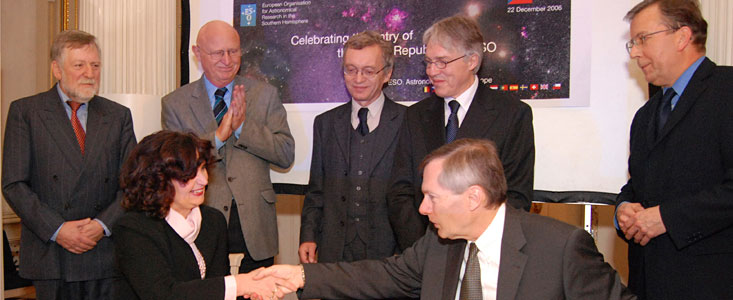Press Release
Czechia to Become Member of ESO
22 December 2006
Today, an agreement was signed in Prague between ESO and Czechia, aiming to make the latter become a full member of ESO as of 1 January 2007.
"The future membership of Czechia in ESO opens for the Czech astronomers completely new opportunities and possibilities. It will foster this discipline on the highest quality level and open new opportunities for Czech industry to actively cooperate in research and development of high-tech instruments for astronomical research," said Miroslava Kopicová, Minister of Education, Youth and Sports of Czechia.
"We warmly welcome Czechia as the thirteenth member of ESO," said Catherine Cesarsky, ESO's Director General. "The timing couldn't be better chosen: with the Very Large Telescope, Europe is now at the forefront of ground-based astronomy, and with the construction of ALMA and the final studies for the European Extremely Large Telescope, we will ensure that this will remain so for several decades. We look forward to working together with our Czech colleagues towards these successes."
The signing event took place at the Czech Ministry of Education, Youth and Sports in Prague. Following ratification by the Czech Parliament, Czechia with thus join the twelve present member states of ESO, the European Organisation for Astronomical Research in the Southern Hemisphere: Belgium, Denmark, France, Finland, Germany, Italy, the Netherlands, Portugal, Spain, Sweden, Switzerland and the United Kingdom. Czechia is the first country from Central and Eastern Europe to join ESO.
Astronomy in Czechia has a very long tradition that dates from as far back as 3500 BC. Four centuries ago, Tycho Brahe and Johannes Kepler established themselves in Prague at the invitation of the emperor Rudolph II, laying the ground for the first golden age in astronomy. Later, eminent scientists such as Christian Doppler, Ernst Mach and Albert Einstein stayed in the famous city for periods of time. The Czech capital also played host to the General Assembly of the International Astronomical Union, first in 1967 and, more recently, in August 2006.
Astronomy in Czechia is shared between the Astronomical Institute of the Academy of Sciences and several leading universities, in Prague, Brno and Opava, among others. The Astronomical Institute operates the Ondrejov Observatory, with a 2-m optical telescope and a 10-m radio telescope. Czech astronomers are very active in many fields of this science, such as solar and stellar physics, and the study of interstellar matter, galaxies and planetary systems.
Created in 1962, ESO, which quite fittingly means 'ace' in the Czech language, provides state-of-the-art research facilities to European astronomers and astrophysicists. ESO's activities cover a wide spectrum including the design and construction of world-class ground-based observational facilities for the member-state scientists, large telescope projects, design of innovative scientific instruments, developing new and advanced technologies, furthering European co-operation and carrying out European educational programmes.
Whilst the Headquarters are located in Garching near Munich, Germany, ESO operates three observational sites in the Chilean Atacama desert. The Very Large Telescope (VLT) is located on Paranal, a 2 600m high mountain south of Antofagasta. At La Silla, 600 km north of Santiago de Chile at 2 400m altitude, ESO operates several medium-sized optical telescopes. The third site is the 5 000m high Llano de Chajnantor, near San Pedro de Atacama. Here a new submillimetre telescope (APEX) is in operation, and a giant array of 12-m submillimetre antennas (ALMA) is under development. Over 1 600 proposals are made each year for the use of the ESO telescopes.

